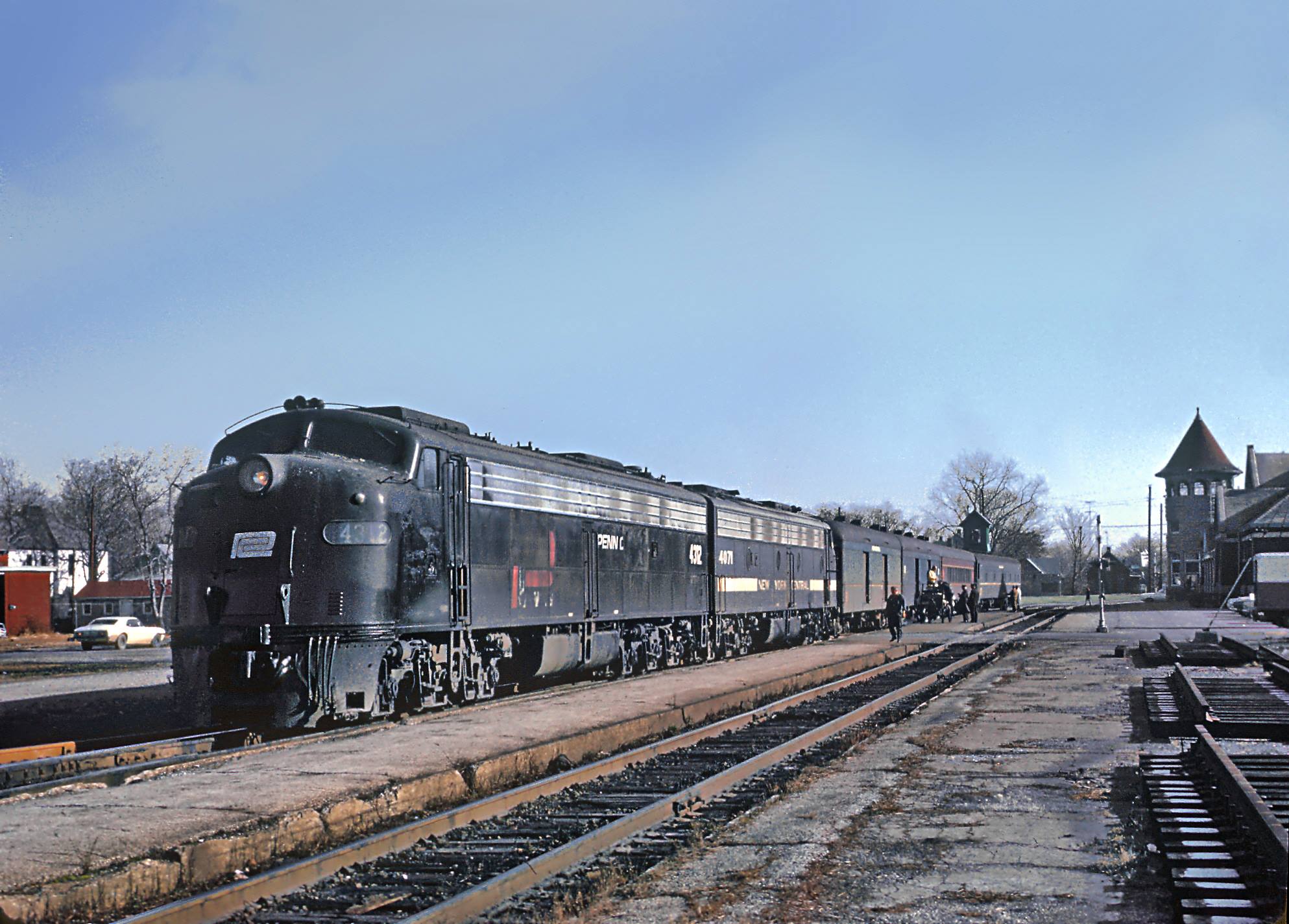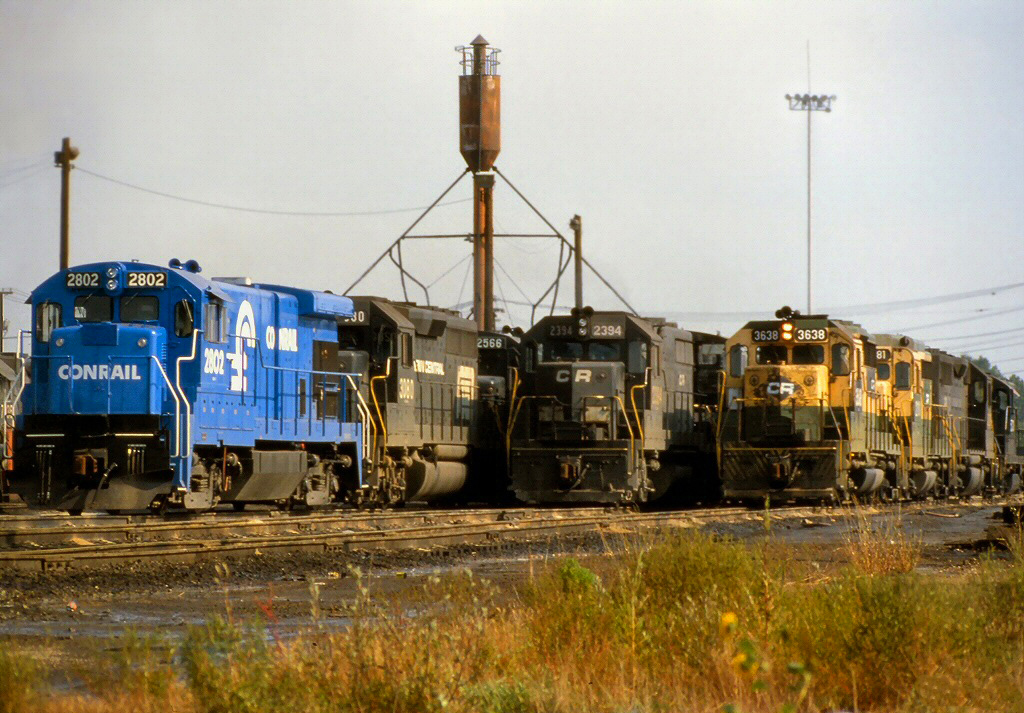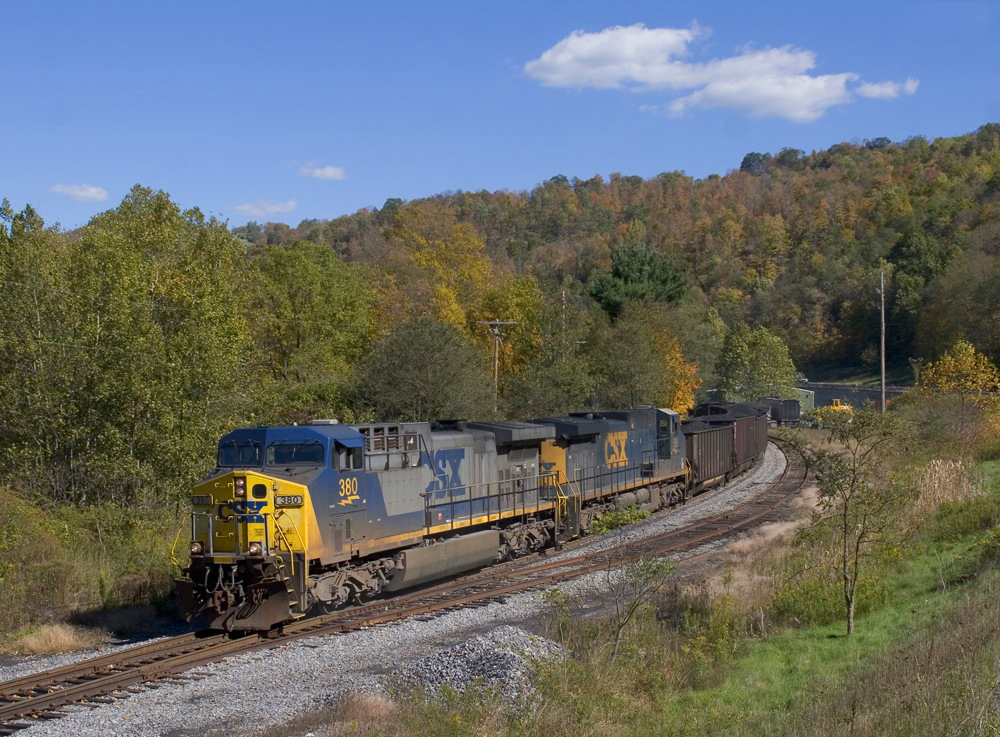Staggers Rail Act (1980): Impact, Importance, Legacy
Published: July 3, 2024
By: Adam Burns
The Staggers Rail Act of 1980 marks one of the most transformative moments in the history of the American railroad industry.
Named after Congressman Harley O. Staggers Sr., who championed the legislation, the Act aimed to deregulate the railroad industry, freeing it from stifling federal controls that had long hampered its flexibility and efficiency.
This article explores the background leading to the Act's passage, the specifics of the legislation, and its profound impact on the railroad sector.
 The Penn Central era is vividly illustrated in this scene; a worn out E8A in fading paint has what remains of Pennsylvania's once proud "Spirit of St. Louis" (westbound train #31, New York - St. Louis) as the train boards in Terre Haute, Indiana on December 14, 1970. Roger Puta photo.
The Penn Central era is vividly illustrated in this scene; a worn out E8A in fading paint has what remains of Pennsylvania's once proud "Spirit of St. Louis" (westbound train #31, New York - St. Louis) as the train boards in Terre Haute, Indiana on December 14, 1970. Roger Puta photo.Historical Context
The period leading up to the enactment of the Staggers Rail Act was characterized by financial difficulties and operational inefficiencies for American railroads.
The industry, heavily regulated by the Interstate Commerce Commission (ICC), faced constraints on pricing, services, and route adjustments.
These regulations, rooted in the early 20th century, aimed at preventing monopoly abuses but had become outdated and overly restrictive by the latter half of the century.
By the 1970s, the railroad industry was in a state of crisis:
- Declining Profitability: Railroads struggled financially, with many companies nearing bankruptcy.
- Competition: The rise of the trucking industry and the expansion of the interstate highway system intensified competition.
- Operational Inefficiencies: Railroads were unable to quickly respond to market changes due to rigid regulatory requirements.
Key Provisions
The Staggers Rail Act was signed into law by President Jimmy Carter on October 14, 1980. The Act ushered in a new era of deregulation, providing railroads with greater autonomy to make business decisions and enhance their competitiveness. Key provisions of the Act included:
1. Rate Flexibility:
Railroads were granted the ability to set their own freight rates, provided there was sufficient competition to protect shippers from monopolistic practices. This shift empowered railroads to be more responsive to market demands and competitive pressures.
2. Contract Rates:
The Act allowed railroads and shippers to enter into confidential contracts, known as contract rates, without the need for ICC approval. This arrangement facilitated more customized and mutually beneficial agreements between railroads and their customers.
3. Route and Service Adjustments:
Railroads were given the authority to change or abandon unprofitable routes and services without prolonged regulatory procedures. This flexibility enabled railroads to focus on more efficient and profitable operations.
4. Revenue Adequacy Standards:
The Staggers Act established revenue adequacy standards, encouraging railroads to achieve a level of earnings sufficient to attract capital and maintain their infrastructure. This provision aimed at fostering long-term financial health for the industry.
5. Labor Provisions:
While the Act reduced regulatory oversight, it retained certain labor protections. However, it streamlined processes for labor negotiations and dispute resolutions, promoting a more harmonious labor-management environment.
 The early Conrail "Rainbow Era" was always interesting with the odd and interesting mix of power. Here, a new B23-7 sets next to former Penn Central and Reading units at the old NYC terminal in Elkhart, Indiana in September of 1977. Rob Kitchen photo.
The early Conrail "Rainbow Era" was always interesting with the odd and interesting mix of power. Here, a new B23-7 sets next to former Penn Central and Reading units at the old NYC terminal in Elkhart, Indiana in September of 1977. Rob Kitchen photo.Immediate Impact
The immediate effects of the Staggers Rail Act were profound and far-reaching. By significantly reducing regulatory constraints, the Act unleashed a wave of innovation and restructuring within the railroad industry. Several immediate impacts included:
1. Increased Efficiency:
Railroads swiftly took advantage of the newfound flexibility to streamline operations. Unprofitable routes were abandoned or sold to smaller operators, while more efficient routing and scheduling practices were implemented.
2. Financial Recovery:
The ability to set competitive rates and negotiate contracts directly with shippers significantly improved the financial performance of railroads. Many companies that had been teetering on the brink of bankruptcy began to recover.
3. Enhanced Competition:
Deregulation fostered greater competition within the industry and with other modes of transportation, particularly trucking. Railroads became more customer-oriented, striving to offer better services and rates to attract business.
4. Capital Investment:
With improved financial health, railroads were able to attract capital and invest in infrastructure, technology, and equipment. These investments enhanced the capacity, reliability, and overall quality of rail services.
Long-Term Effects
While the immediate impacts of the Staggers Rail Act were significant, its long-term effects have arguably been even more transformative, reshaping the landscape of the American railroad industry over the ensuing decades.
1. Revitalized Industry:
The railroad industry experienced a renaissance, marked by sustained profitability, increased productivity, and enhanced service quality. Railroads emerged as a vital component of the nation’s freight transportation system.
2. Market Adaptability:
The deregulated environment enabled railroads to adapt to changing market conditions with agility. This adaptability proved crucial in responding to fluctuations in demand, shifts in commodity flows, and emerging logistical needs.
3. Intermodal Transportation:
The Act encouraged the growth of intermodal transportation, combining rail with other modes such as trucking and shipping. This synergy improved the efficiency of freight movement, providing shippers with seamless and cost-effective logistics solutions.
4. Infrastructure Development:
Investment in infrastructure flourished, with railroads upgrading tracks, terminals, and signaling systems. These improvements not only enhanced the capacity and safety of rail networks but also reduced transit times and operational costs.
5. Environmental Benefits:
As rail transportation is generally more fuel-efficient and environmentally friendly compared to trucking, the revitalization of the railroad industry contributed to reduced greenhouse gas emissions and lessened roadway congestion.
Challenges and Criticisms
While the Staggers Rail Act brought about transformative benefits, it was not without challenges and criticisms. Some of these included:
1. Shipper Concerns:
Despite increased competition, some shippers expressed concerns about potential rate increases and service availability, especially in areas with limited transportation options. Balancing the interests of railroads and shippers remained a delicate issue.
2. Labor Disputes:
The restructuring of the industry led to changes in labor practices, sometimes resulting in job losses and disputes. Addressing labor concerns while maintaining industry competitiveness was an ongoing challenge.
3. Industry Concentration:
The consolidation of railroad companies following deregulation raised concerns about reduced competition and potential monopolistic practices. Ensuring a competitive landscape remained a priority for regulatory oversight.
 Fall has come to the Appalachians of western Maryland as coal drag #B880, led by a pair of AC4400CWs, heads westbound through Morrison and towards the power plant at Mt. Storm, West Virginia on October 13, 2006. Wade Massie photo.
Fall has come to the Appalachians of western Maryland as coal drag #B880, led by a pair of AC4400CWs, heads westbound through Morrison and towards the power plant at Mt. Storm, West Virginia on October 13, 2006. Wade Massie photo.Conclusion
The Staggers Rail Act of 1980 stands as a landmark piece of legislation that fundamentally transformed the American railroad industry. By removing restrictive regulatory controls, the Act empowered railroads to innovate, compete, and thrive.
The immediate and long-term impacts of the Act have been overwhelmingly positive, revitalizing the industry and enhancing its role in the nation’s freight transportation system.
While challenges and criticisms remain, the Staggers Rail Act’s legacy is a testament to the power of regulatory reform in unleashing the potential of an industry.
As the railroad sector continues to evolve, the principles of flexibility, competition, and market responsiveness enshrined in the Staggers Act will continue to guide its journey forward, ensuring that it remains a vibrant and essential component of America's transportation infrastructure.
Recent Articles
-
Oregon Railroad Museums: A Complete Guide
Apr 25, 25 03:11 PM
With its rich tapestry of scenic landscapes and profound historical significance, Oregon possesses several railroad museums that offer insights into the state’s transportation heritage. -
North Carolina Railroad Museums: A Complete Guide
Apr 25, 25 02:56 PM
Today, several museums in North Caorlina preserve its illustrious past, offering visitors a glimpse into the world of railroads with artifacts, model trains, and historic locomotives. -
New Jersey Railroad Museums: A Complete Guide
Apr 25, 25 11:48 AM
New Jersey offers a fascinating glimpse into its railroad legacy through its well-preserved museums found throughout the state.

